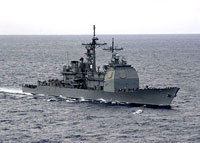
USS San Jacinto (CG-56)
This has not been a good few months for Aegis missile cruisers. In August, USS Porter collided with a VLCC (a large tanker) near the Strait of Hormuz. Yesterday at around 3:30 PM, during routine operations, the Aegis cruiser USS San Jacinto collided with nuclear submarine USS Montpelier off the northeast coast of Florida. A statement issued by the Navy says that there were no injuries aboard either ship and that the submarine’s nuclear powered reactor “was unaffected by this collision.”
Navy Submarine and Cruiser Collide Off Florida
Reportedly, the submarine rose to periscope depth 100 to 200 yards ahead of the cruiser. Despite ordering emergency full astern, the cruiser struck the submarine. Damage to the USS San Jacinto’s sonar dome in the ship’s bow was reported.
The last time two US Navy vessels collided was in 2009 when the submarine USS Hartford suffered severe damage after colliding with the amphibious transport ship USS New Orleans in the Strait of Hormuz.
Both ship’s involved in yesterday’s collision can claim “firsts.” USS San Jacinto fired the opening shots of Gulf War in 1990 with the launch of two BGM-109 Tomahawk cruise missiles. USS Montpelier was the first submarine to launch Tomahawk cruise missiles in Iraq War in 2003.
Thanks to Alaric Bond for passing along the news.

USS Porter (DDG 78) is not a Cruiser. Still, not a stellar bit of shiphandling.
You are right. The Porter is an Arleigh Burke class destroyer and the San Jacinto is Ticonderoga-class cruiser. A cruiser is larger than a destroyer but less heavily armed than a battleship. OK.
And yet, the Porter and the San Jacinto are very similar in size. The San Jacinto is slightly longer, about 60′, but is narrower than the Porter by around 10′. Both are roughly the same displacements – 8,900 vs 9,600 long tons.
Where exactly is a dividing line between cruiser and destroyer? I do not claim to know much about the Grey Stack Line, so any guidance is appreciated.